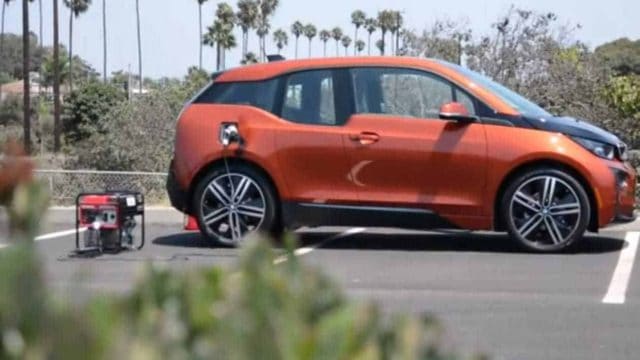Electric cars (EVs) have been around us for quite some time now. The rise of EVs is mainly motivated by the need to use green energy. For this reason, it might be uncommon in some areas to talk about charging an EV from a generator. This relatively unknown EV charging hack comes in handy in several situations.
You can charge an electric car with a portable generator in case of emergencies or maybe when you are on the route where you know that you won't find any charging stations.
Read on to find out if you can charge an electric car with the likes of a portable generator.
When do you Need a Portable Generator for your EV?
Buying an EV would most likely be motivated by the need to avoid using gas.
Why else would you want a generator running on gas to power your EV?
These factors may call for a second thought regarding owning a generator.

Source: Green Car
During Power outages
The national grid is the primary source of juice for electric cars. Scheduled maintenance and/or adverse weather conditions can cause prolonged periods of a power outage.
During these periods, you still most probably need to move around. For such cases, it is always good to have a backup generator.
In Off-Grid areas
Not every place is well served by the national grid system. Some areas also have power but not enough charging stations.
If you live somewhere far from a charging station and possibly do not have the means to charge at home from the grid, investing in a generator would save you countless times.
On Camping Sites
Camping sites are not exactly the place for charging EVs. In fact, such places are usually off the grid.
Are you planning to use your Tesla for the adventure?
It's good to have some power source to aid moving around.
During Emergencies
Assuming that you know the potential risks of charging your car from a generator, you might sometimes have to do it to save a situation.
Having a portable power generator handy can save the day in time of emergency.
Now that you know if and when you might need a backup generator, it is equally important to understand how to choose the most convenient portable generator for your car.
A wrong choice can frustrate you just when in need.
This is how to choose the best emergency power kit for your EV.
Factors to Consider When Choosing a Portable Generator for your EV
All EVs are equipped with power sensing and regulating mechanisms. These mechanisms could spell doom for your day if your generator doesn't meet the set standards.
Let's see what to consider and avoid making awful choices regarding portable EV generators.
Output Wave
Most modern EVs require that the charging current is a clean sine wave output. The generator you choose should be an inverter generator.
Inverter generators cost a fortune compared to others that produce a modified sine wave. For example, the most popular EV, Tesla, has a charging system that doesn't charge if the power is anything but a clean sine wave.
Other brands like Nissan Leaf and Chevy Volt have similar features to protect the car against surges while charging.
Always insist on an inverter with a pure sine wave output.
Grounding
Again, modern EVs are never short of protective mechanisms. To charge an electric car with a generator, the generator itself needs to be properly grounded.
If the EV detects that the ground is not proper, it doesn't charge.
There are ways of bypassing this, but of course, you will instantly void the car's warranty. On top of that, you need considerable electrical and electronic circumnavigation skills.
To avoid a rainy day getting messier, buy a portable generator with a proper ground, or learn how to ground it appropriately.
Amperage
The size and rating of the generator are directly proportional to how fast and far you can go with, say, a one-hour charge. A rating of not less than 1500W is good to go.
Usually, EVs draw between 32 and 40 amperes.
Before you plug in the supply from a 28-amp generator, make sure to tune down the car's charging amperage, lest you overload your pricey portable generator.
Pro Tip
Charging an EV from a portable generator is going to take you a day or nearly as long. Since you only need the power to get you to a charging station, you probably do not need a full charge. A few hours of charging from the generator is all you need. It saves you both time and money for gas.
Maintenance
Is convenience not the main reason you'd need a portable generator for your EV?
What if the generator doesn't start when you need it?
To avoid such situations, regular maintenance of your generator is as vital as having the generator. If you cannot perform the maintenance yourself, make sure to have the generator maintained and serviced regularly.
You can also purchase a low-maintenance premium generator, which needs service once in a while.
This brings us to another important topic- how do you properly care for your generator?
Portable Generator Care Tips
To get the best out of your inverter generator, you need to treat it right. Make good reference to these points, and you could brag about owning the most original powerhouse.
Maintenance Schedule
Every manufacturer provides a well-calculated maintenance schedule. This is like an immunization schedule that thwarts some known problems from occurring. To ensure optimum running and lifespan of the generator, do not miss a service schedule.
Never Run dry
Generators and other internal combustion engines suffer if they run to the last drop of gas. Apart from straining the generator's coils, the practice also shortens the unit's lifespan.
Stale Gas is a Big No!
Gas stored in the unit's tank can be stale in a few weeks.
To avoid this, add a fuel stabilizer whenever reserving for a long time, or drain the remaining fuel before storing the unit.
Shelter the Generator
One of the ways to technically kill an internal combustion (IC) engine is exposing it to moisture, especially rain.
Whenever using or storing the portable generator, shelter it adequately.
Watch the Limit
Never plug the power from your generator without checking the car's amperage. Drawing up more current than the generator's rated capacity will only ruin it.
With all that said, you must be wondering how to charge an electric car with a portable generator. It is just as simple as charging it at the station.
How to Charge an Electric Car from an Inverter generator?
At this point, I assume you know how to start and adjust a generator.
After it is up and running, you should check the amperage and adjust it to the lowest charge to protect your motor.
You should also know how much charge your car requires. With that, you can now go ahead and start charging your EV. Knowing the dos and don'ts of charging an EV is also important.
Some big-name brands have all the mechanisms to protect the car from damages resulting from improper charging.
Can you charge your EV on the Go?
One thing that most people wonder is if you could charge your vehicle on the go.
The answer is yes, but it is one of the worst things you can do to your car. You will need to rewire some electrical components for a Tesla or a BMW i3 to move with the power cord still connected. You only bypass the safety measures at your own risk.
As discussed earlier, the generator you choose for your car should meet certain conditions if not to disappoint. These models satisfy those criteria and can make your day run like there was no outage at all.
Affiliate Disclaimer
Thejustread.com is an Associate Member in the several Affiliate Programs including Amazon Associates Program. We may earn a commission for qualified purchases through links on our site.
Some Popular Generators Models For Charging Your EV
This 1.06-gallon powerhouse comes with a minimum power rating of 2000W at a potential difference of 120V and 60hz of a clean sine wave frequency. It comes with two modes, Economy and Turbo. Depending on how fast you want to get your car charged, you can choose from these two. It is also very easy to use and monitor as it has a start/run/stop dial and a power monitor to show the wattage spent.
Even though this model is no longer in production, the units still used today continue to treat the owners satisfactorily.
This inverter generator is also an easy one to use. You only need to choke, open the vent, and turn on the engine. It has the full-throttle mode as the default but has a switch that can change it to the eco-mode, which is less noisy but outputs a lower power level.
The overload alarm, oil alert, and output indicator lights ensure you never have to guess anything. A power output of 2200W will get your car ready in a matter of hours.
This is a powerful version of the EU2200i. The 7000W output gets things done even faster, so you don't lag on your schedules. The output is a pure sine-wave (just like the EU2200i), ideal for Teslas and BMW i3s.
At half-load, this 9200W powerhouse can run for 10 hours, thanks to the 7.7-gallon gas tank. At full capacity, it is needless to say that it charges your EV as fast as a charging station would charge. This also means that the generator can serve other purposes while on off-grid camping, for example.
The convenient pure sine-wave output places this generator as an ideal substitute for grid supply if you have to choose between the two.
Wrapping it up
Charging a car with a portable inverter generator is a likely situation for every EV owner. Comprehending how to charge an electric vehicle right and safely is another level of convenience for a driver.
Putting the guidelines discussed here into practice will yield you the best results, if not safeguarding your precious car. As you charge from the generator, do not forget the precautions, as it could be the difference between remaining stuck and having a good day.
Sources:
https://www.tflcar.com/2020/01/electric-car-generator-charging-video/
Can I Charge a Tesla Using a Portable Generator?
Taking Care of Your Portable Generator
Can a Portable Generator Charge a Tesla? What You Need to Know




